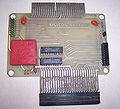Difference between revisions of "AMRAM2"
| Line 3: | Line 3: | ||
The AMRAM has two PCBs sitting on top of each other, joined with a rigid connector. | The AMRAM has two PCBs sitting on top of each other, joined with a rigid connector. | ||
| − | On the bottom is passthrough for other expansion connectors and a 3V square lithium battery. (The exact replacement battery is expensive. It *is* possible to fit a PC CMOS compatible lithium battery and holder, but it's not as neat and there is not a lot of space between the two pcb boards of the Amram) | + | On the bottom is passthrough for other expansion connectors and a 3V square lithium battery. (The exact replacement battery is expensive. It *is* possible to fit a PC CMOS compatible lithium battery (CR2032) and holder, but it's not as neat and there is not a lot of space between the two pcb boards of the Amram) |
On the top, 32K RAM (contents are held by lithium battery so can survive a reset or power off), which can be programmed like ROM and occupies two ROM positions (1 and 2) and also sockets for expansion ROMs up to ROM 7. | On the top, 32K RAM (contents are held by lithium battery so can survive a reset or power off), which can be programmed like ROM and occupies two ROM positions (1 and 2) and also sockets for expansion ROMs up to ROM 7. | ||
Revision as of 06:36, 27 August 2010
AMRAM2 is a ROM board from Silicon Systems.
The AMRAM has two PCBs sitting on top of each other, joined with a rigid connector.
On the bottom is passthrough for other expansion connectors and a 3V square lithium battery. (The exact replacement battery is expensive. It *is* possible to fit a PC CMOS compatible lithium battery (CR2032) and holder, but it's not as neat and there is not a lot of space between the two pcb boards of the Amram)
On the top, 32K RAM (contents are held by lithium battery so can survive a reset or power off), which can be programmed like ROM and occupies two ROM positions (1 and 2) and also sockets for expansion ROMs up to ROM 7.
There is a bank of DIP switches to enable/disable ROM slots, a switch to enable/disable writes to 32K RAM (left side of top pcb), a LED to indicate RAM is ready to write and a switch to reset computer (right side of top pcb).
It seems the first few batches of these were distributed without boxes, so you had to provide your own. A suitable box can be made from a "General purpose ABS Enclosure" which is a black plastic box designed for electronics. This is the type of box shown in the picture.
Came with software to program it.
This came after the AMRAM which was 16K ram on a board which could be programmed and which occupied ROM slot 5. More details when I can find them in my documents.
Pictures
Files
Amram 2 user manual: File:Amram2.pdf




